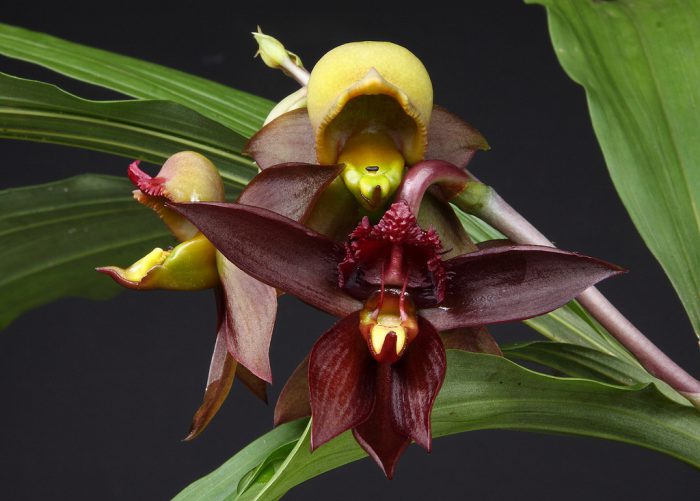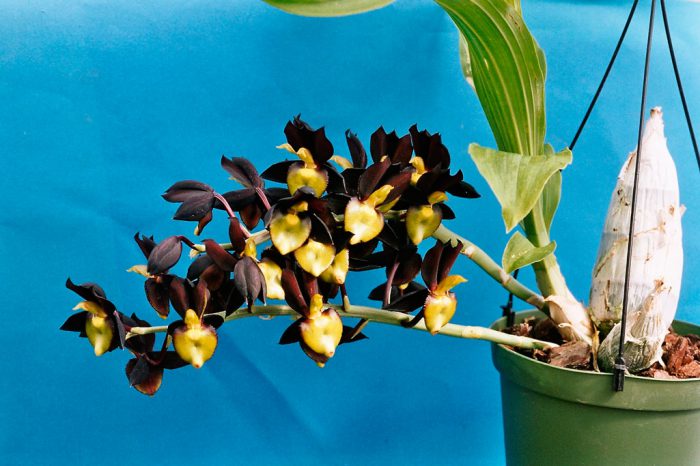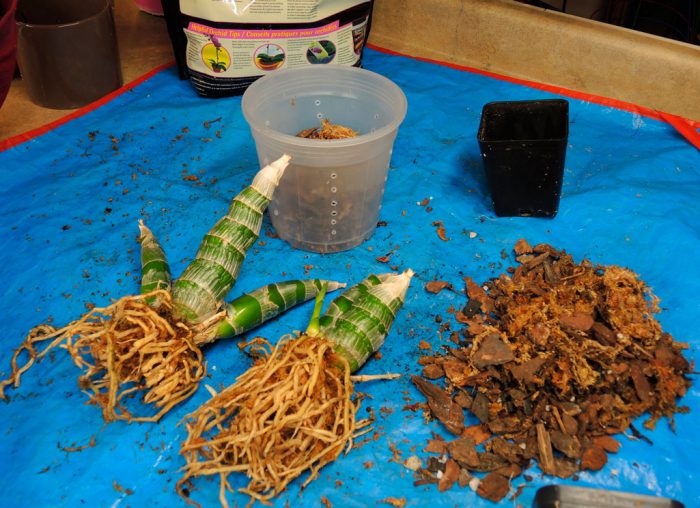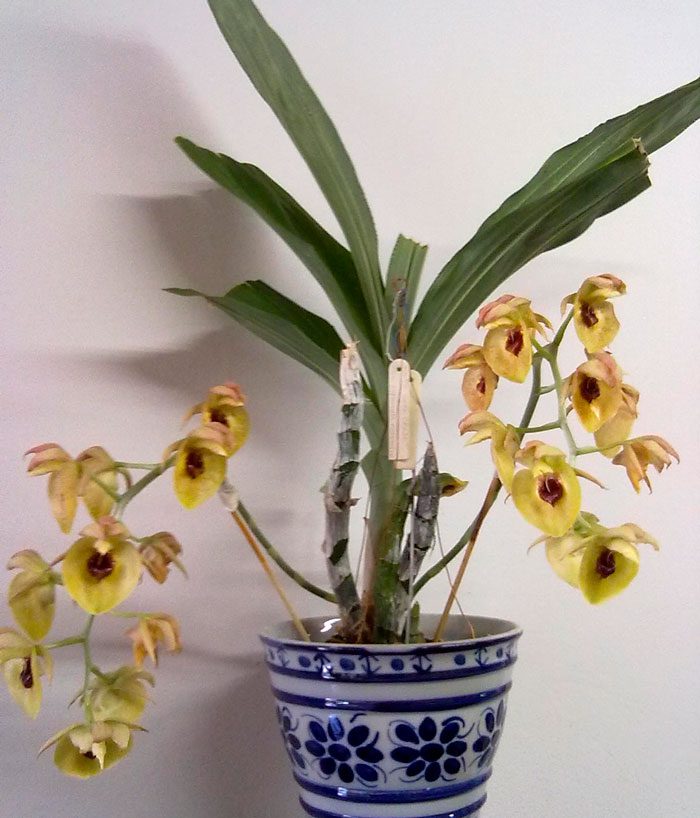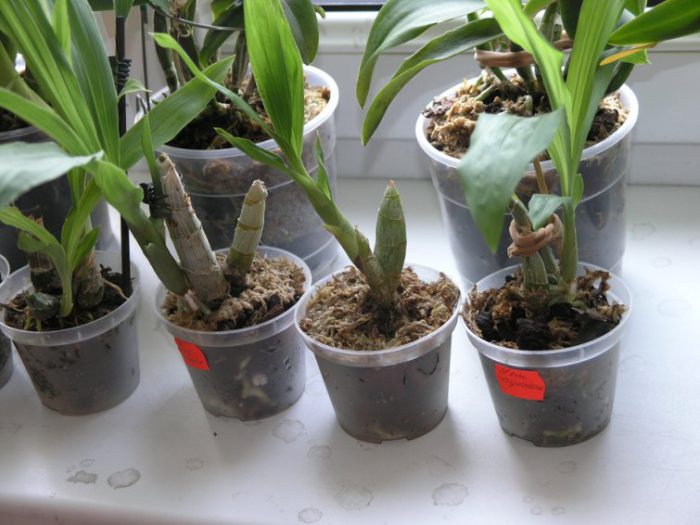Orchid genus catasetum (Catasetum) is represented by epiphytes. It brings together about 150 plant species. They can be found in nature in South and Central America. Most often, these plants are found in Brazil.
This plant has a sympodial growth pattern. It has a shortened rhizome (creeping shoot), while it is tightly pressed to the ground, which is why young pseudobulbs grow almost closely to the old ones. Clustered elongated oval pseudobulbs are similar to wrinkled green cigars, which have pointed ends. In species that are large enough, mature pseudobulbs reach 20 centimeters in height and 7 centimeters in diameter. Young pseudobulbs that are not yet 1 year old are leafy, and adults are completely naked. There are many sheaths, usually 3 to 7 pairs. The part located at the bottom of the sheet plate is film, and it acts as a wrapper. So, after the leaf dies off and dries, this tissue remains on the surface of the pseudobulb, and it does not allow the accumulated moisture to evaporate too quickly. Thin leathery leaves have a pointed-oval shape with a distinct longitudinal venation. In length, they reach from 20 to 30 centimeters.
This genus of orchids stands out from the rest in that it has a pronounced sexual dimorphism of flowers. The flowers, which are male, have a larger size (diameter from 10 to 12 centimeters), they are complex and colored in a rich color, there are much more of them on the peduncle. The female flowers are not so large and have a relatively simple appearance. A large number of species have resupinated male flowers (turned upside down), and a large lip, curled up into a funnel or shaped like a bent bowl, hangs over the flower. Fleshy petals (petals) and sepals (sepals) are oval or lanceolate. The elongated column has several stamens. All female flowers are "correct", their lip looks like a helmet, while the column is not as long and thin as that of the male flower.
Content
Caring for the catasetum orchid at home
Most of the species of such orchids are recommended to be grown in an orchidarium or in a greenhouse. And there are those species that are not able to grow in indoor conditions at all, falling into an unfamiliar environment for themselves, they die very quickly.
Temperature regime
Such a plant needs a warm temperature regime, while it must be sure to provide a drop in daily temperatures. Thus, the catasetum will normally grow and develop at a daytime temperature of 29–32 degrees, and a night temperature of 21–24 degrees.
If desired, this flower can be transferred to the street. There he can stay from mid-May to mid-September. A garden or balcony is perfect for this. In this case, the required difference in daily temperatures will be natural.
Illumination
The flower needs bright lighting throughout the year, but at the same time it must be diffused. Experienced florists recommend placing such an orchid under powerful phytolamps, thus replacing natural lighting with artificial ones. Daylight hours should be 10 hours long.
Plants with leafy pseudobulbs, as well as those with blossoming flowers, when kept outdoors, should be placed in places protected from direct sunlight. The fact is that burns may appear on flowers, as well as on delicate foliage. However, it should be borne in mind that it is not recommended to place the catasetum in a too shaded place.
Earth mix
Blocks and pots are used for growing. To fill the pot, a substrate is used, consisting of pieces of coarse pine bark, a small amount of sphagnum and charcoal.
A large piece of pine bark is most often used as a block. On its surface, the roots and rhizome of the plant are reliably fixed, while they are pre-wrapped with a not very thick layer of moss.
How to water
It is worth remembering that between waterings, the bark must definitely dry out well. It is recommended to water this flower not in the usual way, but by immersing a block or pot in a basin filled with water. You should wait until the bark and root system are saturated with liquid, and then remove the flower from the water. When excess liquid drains, the catasetum should be returned to its usual place.
In order to stimulate flowering, orchidists with considerable experience are advised to arrange a "hot shower" for the plant along with watering, or to immerse the flower completely under water, which should be preheated to 35 degrees.
Humidity
Such a plant reacts extremely negatively to low air humidity. The optimum moisture content for this flower is 70-80 percent. In order to increase the humidity to the required level, you need to use household humidifiers or steam generators. If the catasetum is grown in an orchidarium, then it should be remembered that stagnant damp air can cause fungal diseases. In this regard, for prevention purposes, systematic ventilation is recommended.
Dormant period
The dormant period for this orchid begins in mid-November. The fact is that at this time in the places where she comes from, a cool and dry period begins. The air temperature during this period should be from 18 to 20 degrees, while watering should be stopped altogether, but the illumination should be left at the same level. If the pseudobulbs wrinkle very strongly, then to maintain them in a healthy state, the substrate should be systematically sprayed, but only slightly. Watering is fully started after young pseudobulbs appear, as well as the first roots.
If you abandon the dormant period, then the plant will bloom very poorly, and after a while the flowering may stop altogether.
Transplant features
The transplant is carried out once a year. The fact is that during the dormant period, some roots die off in the catasetum, which not only contaminate the substrate, but also cause the appearance of various fungi and bacteria. It is necessary to transplant at the beginning of the growing season, at a time when new roots are intensively growing in young pseudobulbs.
Fertilizer
They are fed once a week.To do this, use a special complex fertilizer for orchids, while the dosage should be seen on the package. Fertilizer, as a rule, is dissolved in water for moistening from a sprayer or irrigation.
During the dormant period, the flower is not fertilized.
Reproduction methods
When grown indoors, the catasetum can be propagated by dividing its rhizome, which should be overgrown, into parts. It should be remembered that each division must have at least 3 mature pseudobulbs.
Under industrial conditions, this plant is propagated by seeds and meristemally.
Pests and diseases
It is very common to settle on young leaves spider mite... If such a pest is found, the flower should be given a warm (about 45 degrees) shower, while the leaves should be thoroughly rinsed. If there is such a need, then the procedure must be repeated.
In the event that the catasetum is not provided with optimal conditions, it may stop flowering, the growth of new pseudobulbs, and in some cases it even dies.

